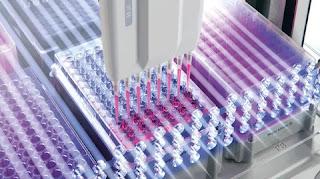- Get link
- X
- Other Apps
- Get link
- X
- Other Apps
 |
Automated liquid handling systems
are unique in the ever-changing field of laboratory automation because they are
powerful engines of accuracy and productivity. These systems are changing how
scientific study and testing are carried out across a variety of industries
since they are outfitted with cutting-edge technologies and sophisticated
software. A constant emphasis on accuracy and precision, smooth connection with
data management systems, and a move toward modular and scalable architectures
are some of the major themes propelling this growth.
In the realm of scientific research and
experimentation, precision is paramount. Every detail matters, and even the
smallest error can lead to significant consequences. This is where automated
liquid handling systems step in, offering a glimpse into the future of precise,
efficient, and error-free laboratory workflows.
The
Rise of Automation
Automation has become a cornerstone of modern
laboratories, revolutionizing processes and workflows across various scientific
disciplines. Automated Liquid Handling
Systems, often equipped with advanced robotics and software, are
at the forefront of this transformation. These systems are designed to handle
liquids with unparalleled accuracy, consistency, and speed, significantly
enhancing the reliability and reproducibility of experiments.
Enhanced
Accuracy and Consistency
One of the primary advantages of automated liquid
handling systems is their ability to deliver precise volumes of liquids
consistently. Traditional manual pipetting is prone to human error, leading to
variations in results and compromising the integrity of experiments. In
contrast, automated systems can execute pipetting tasks with micron-level
accuracy, ensuring reliable outcomes and minimizing variability between
samples.
Streamlined
Workflows and Efficiency Gains
By automating repetitive pipetting tasks,
laboratories can streamline their workflows and achieve substantial efficiency
gains. Automated liquid handling systems can handle multiple samples
simultaneously, execute complex pipetting sequences with ease, and operate
around the clock without fatigue or errors. This not only accelerates the pace
of research but also frees up scientists' time to focus on data analysis,
interpretation, and innovation.
Integration
with Advanced Technologies
The future of automated liquid handling systems lies
in their integration with advanced technologies such as artificial intelligence
(AI) and machine learning (ML). These systems can learn from past experiments,
optimize protocols, and adapt to evolving research needs. AI-driven algorithms
can also identify patterns, detect anomalies, and suggest optimizations,
further enhancing the precision and efficiency of laboratory processes.
Customization
and Flexibility
Modern automated liquid handling systems offer a
high degree of customization and flexibility to meet diverse experimental
requirements. Scientists can configure these systems to accommodate various
sample types, volumes, and assay formats, allowing for seamless integration
into existing laboratory setups. Additionally, modular designs enable
scalability, enabling laboratories to expand their automation capabilities as
needed.
Quality
Assurance and Compliance
In regulated industries such as pharmaceuticals and
biotechnology, compliance with quality standards and regulations is
non-negotiable. Automated liquid handling systems play a crucial role in
ensuring data integrity, traceability, and compliance with Good Laboratory
Practices (GLP) and other regulatory requirements. Built-in features such as
audit trails, user access controls, and calibration routines uphold the highest
standards of quality assurance.
Emerging
Trends and Innovations
The landscape of automated liquid handling systems
continues to evolve, driven by ongoing technological advancements and industry
trends. Key developments include the integration of robotic arms for sample
manipulation, the use of disposable tips to prevent cross-contamination, and
the adoption of cloud-based software for remote monitoring and control.
Furthermore, advancements in liquid handling techniques, such as acoustic and
pressure-based dispensing, offer novel solutions for challenging applications.
Collaborative
Ecosystems and Knowledge Sharing
The future of precision in automated liquid handling
systems also hinges on collaborative ecosystems and knowledge sharing within
the scientific community. Researchers, manufacturers, and technology providers
are actively collaborating to co-create innovative solutions, share best practices,
and address common challenges. This collaborative approach fosters continuous
improvement and drives the rapid evolution of automated liquid handling
technologies.
The future of precision in scientific research is intricately
linked to the evolution of automated liquid handling systems. These systems not
only promise unparalleled accuracy, efficiency, and flexibility but also pave
the way for groundbreaking discoveries and advancements across various domains.
Embracing automation and leveraging cutting-edge technologies will undoubtedly
shape the next chapter of scientific innovation.
Get more insights on Automated Liquid Handling Systems
- Get link
- X
- Other Apps
Comments
Post a Comment